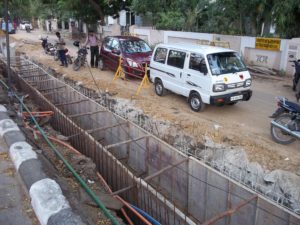
The northeast monsoon in the first week of November has been heavy with a torrential downpour in Chennai city, and suburbs, as per the forecast correctly made several weeks earlier. It caused severe disruption for a few days, disrupting traffic, water entering into some residences and with loss of lives. A careful study of the scenario highlights the fact that such disruptions are avoidable with proper management.
Excess rain in the monsoon period should be managed in such a way, to void floods and store and preserve the water to meet the need of the summer months.
By collecting and storing the water in numerous reservoirs and lakes in Tamil Nadu, flood during monsoon period can be avoided and water starvation during summer months can be eliminated.
Now, it has become routine for Tamil Nadu citizens and the farmers to suffer from excess rain between October and December and suffer from lack of water in summer days.
Choked waterways in Chennai:
There are the waterways in Chennai with the length of around 23 kilometers served by Buckingham canal, Cooum river, Adyar river and others, which now remain mostly choked. Hundreds of crores of rupees have been spent by the government of Tamil Nadu during the last several years to remove the sludge in these canals and make the water flow smoothly. All such investments have virtually been wasted due to an unacceptable level of inefficiency and nepotism in executing the work by ministers / government officials.
The choked canals prevent the smooth water flow during the excess rain and cause flooding.
There are nine sewage treatment plants in the periphery of Chennai city. The treated water from these sewage treatment plants is let into the above canals to be let into the Bay of Bengal. However, huge quantity of untreated sewage is let into the channels that take the treated water from the sewage treatment plants to the canal and sea. This results in a scenario where the sewage water gets mixed with treated water and choke the canals.
The Tamil Nadu government has been spending several crores of rupees for clearing the choke without taking steps to avoid the sludge getting into the canal.
Failure of desilting measures :
There are around 40,000 tanks and 79 reservoirs in Tamil Nadu. This includes around 400 tanks in Chennai city. Around 20% of the water holding capacity of these tanks and reservoirs have been lost due to the accumulation of sludge and silt. The total storage capacity of these tanks and reservoirs is more than the storage capacity of all the dams in Tamil Nadu.
Desilting of the 40 000 tanks and 79 reservoirs in the state is the only way to improve their effective storage capacity, avoid floods and store and conserve water.
All the efforts of the Tamil Nadu government and huge money spent for desilting operations for the last fifty years or so have failed due to corruption in awarding contracts, poor execution of work and lack of supervision by the government officials.
The new Kudimaramathu scheme to desilt tanks has not served the purpose efficiently since the task was given only to the farmers with cumbersome procedures and it was not open for public.
First suggestion:
The suggestion is to let anyone, whether individual or groups to take the silt from the reservoirs and tanks free of charge and use it for whatever purposes and in the process, they can earn income. Some guidelines and rules can be stipulated by the government for this purpose.
Top half foot of the silt can be used as agriculture input. Next half foot of the silt can be used for making bricks. Next two feet of the silt can be used for laying roads and for construction purposes to some extent.
A few years back, when there was a storm, several trees fell in the Chennai city, and Chennai Corporation asked the people to take away the fallen trees without paying any price. The city was cleared of fallen trees in just two days.
During the last year’s vardha cyclone, when trees fell in huge number in Chennai city, Chennai corporation insisted that it would remove the trees by itself. Labourers were brought in from all over Tamil Nadu. It took several days to remove the fallen trees and take it to the collection point and then auction it. It is reported that the money realized by the Chennai Corporation in auctioning the fallen trees was less than the money spent by the Chennai Corporation for removal of the fallen trees.
Leaving the desilting operation of tanks and reservoirs to the people will ensure quick completion of the job and at no cost to the government.
Second suggestion:
Under the corporate social responsibility ( CSR) scheme of Government of India, every company in the private and public sector that has a net worth of Rs. 500 crore or annual turn over of Rs. 1000 crore and a net profit of around Rs. 5 crore has to compulsorily spend 2% of the profit for CSR activity.
Tamil Nadu government should persuade the companies in public and private sector operating in Tamil Nadu to use the CSR funds for cleaning the Cooum, Buckingham and other canals in Chennai city as well as the canals all over Tamil Nadu. The companies can do this job competently and efficiently and in a way much better than the government officials and complete the task in quick time.
On the other hand, at present, the CSR funds are spent by the companies without any coordinated action plan or guidance from the government.
MONSOON RAINS BRING CHENNAI CITY TO THE KNEES – SHOULD IT BE SO BAD?

The northeast monsoon in the first week of November has been heavy with a torrential downpour in Chennai city, and suburbs in India, as per the forecast correctly made several weeks earlier. It caused severe disruption for a few days, disrupting traffic, water entering into some residences and with loss of lives. A careful study of the scenario highlights the fact that such disruptions are avoidable with proper management.
Excess rain in the monsoon period should be managed in such a way, to void floods and store and preserve the water to meet the need of the summer months.
By collecting and storing the water in numerous reservoirs and lakes in Tamil Nadu, flood during monsoon period can be avoided and water starvation during summer months can be eliminated.
Now, it has become routine for Tamil Nadu citizens and the farmers to suffer from excess rain between October and December and suffer from lack of water in summer days.
Choked waterways in Chennai:
There are the waterways in Chennai with the length of around 23 kilometers served by Buckingham canal, Cooum river, Adyar river and others, which now remain mostly choked. Hundreds of crores of rupees have been spent by the government of Tamil Nadu during the last several years to remove the sludge in these canals and make the water flow smoothly. All such investments have virtually been wasted due to an unacceptable level of inefficiency and nepotism in executing the work by ministers/government officials.
The choked canals prevent the smooth water flow during the excess rain and cause flooding.
There are nine sewage treatment plants in the periphery of Chennai city. The treated water from these sewage treatment plants is let into the above canals to be let into the Bay of Bengal. However, huge quantity of untreated sewage is let into the channels that take the treated water from the sewage treatment plants to the canal and sea. This results in a scenario where the sewage water gets mixed with treated water and choke the canals.
The Tamil Nadu government has been spending several crores of rupees for clearing the choke without taking steps to avoid the sludge getting into the canal.
Failure of desilting measures :
There are around 40,000 tanks and 79 reservoirs in Tamil Nadu. This includes around 400 tanks in Chennai city. Around 20% of the water holding capacity of these tanks and reservoirs have been lost due to the accumulation of sludge and silt. The total storage capacity of these tanks and reservoirs is more than the storage capacity of all the dams in Tamil Nadu.
Desilting of the 40 000 tanks and 79 reservoirs in the state is the only way to improve their effective storage capacity, avoid floods and store and conserve water.
All the efforts of the Tamil Nadu government and huge money spent for desilting operations for the last fifty years or so have failed due to corruption in awarding contracts, poor execution of work and lack of supervision by the government officials.
The new Kudimaramathu scheme to desilt tanks has not served the purpose efficiently since the task was given only to the farmers with cumbersome procedures and it was not open for public.
First suggestion:
The suggestion is to let anyone, whether individual or groups to take the silt from the reservoirs and tanks free of charge and use it for whatever purposes and in the process, they can earn income. Some guidelines and rules can be stipulated by the government for this purpose.
Top half foot of the silt can be used as agriculture input. Next half foot of the silt can be used for making bricks. Next two feet of the silt can be used for laying roads and for construction purposes to some extent.
A few years back, when there was a storm, several trees fell in the Chennai city, and Chennai corporation asked the people to take away the fallen trees without paying any price. The city was cleared of fallen trees in just two days.
During the last year’s vardha cyclone, when trees fell in huge number in Chennai city, Chennai corporation insisted that it would remove the trees by itself. Labourers were brought in from all over Tamil Nadu. It took several days to remove the fallen trees and take it to the collection point and then auction it. It is reported that the money realized by the Chennai Corporation in auctioning the fallen trees was less than the money spent by the Chennai Corporation for removal of the fallen trees.
Leaving the desilting operation of tanks and reservoirs to the people will ensure quick completion of the job and at no cost to the government.
Second suggestion:
Under the corporate social responsibility ( CSR) scheme of Government of India, every company in the private and public sector that has a net worth of Rs. 500 crore or annual turn over of Rs. 1000 crore and a net profit of around Rs, five crore has to spend 2% of the profit for CSR activity compulsorily.
Tamil Nadu government should persuade the companies in public and private sector operating in Tamil Nadu to use the CSR funds for cleaning the Cooum, Buckingham and other canals in Chennai city as well as the canals all over Tamil Nadu. The companies can do this job competently and efficiently and in a way much better than the government officials and complete the task in quick time.
On the other hand, at present, the CSR funds are spent by the companies without any coordinated action plan or guidance from the government.
